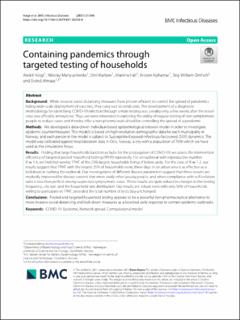| dc.contributor.author | Voigt, Andre | |
| dc.contributor.author | Martyushenko, Nikolay | |
| dc.contributor.author | Karlsen, Emil | |
| dc.contributor.author | Hall, Martina | |
| dc.contributor.author | Nyhamar, Kristen | |
| dc.contributor.author | Omholt, Stig William | |
| dc.contributor.author | Almaas, Eivind | |
| dc.date.accessioned | 2022-09-26T08:15:07Z | |
| dc.date.available | 2022-09-26T08:15:07Z | |
| dc.date.created | 2021-06-11T16:02:47Z | |
| dc.date.issued | 2021 | |
| dc.identifier.citation | BMC Infectious Diseases. 2021, 21 . | en_US |
| dc.identifier.issn | 1471-2334 | |
| dc.identifier.uri | https://hdl.handle.net/11250/3021190 | |
| dc.description.abstract | Background
While invasive social distancing measures have proven efficient to control the spread of pandemics failing wide-scale deployment of vaccines, they carry vast societal costs. The development of a diagnostic methodology for identifying COVID-19 infection through simple testing was a reality only a few weeks after the novel virus was officially announced. Thus, we were interested in exploring the ability of regular testing of non-symptomatic people to reduce cases and thereby offer a non-pharmaceutical tool for controlling the spread of a pandemic.
Methods
We developed a data-driven individual-based epidemiological network model in order to investigate epidemic countermeasures. This models is based on high-resolution demographic data for each municipality in Norway, and each person in the model is subject to Susceptible-Exposed-Infectious-Recovered (SEIR) dynamics. The model was calibrated against hospitalization data in Oslo, Norway, a city with a population of 700k which we have used as the simulations focus.
Results
Finding that large households function as hubs for the propagation of COVID-19, we assess the intervention efficiency of targeted pooled household testing (TPHT) repeatedly. For an outbreak with reproductive number R=1.4, we find that weekly TPHT of the 25% largest households brings R below unity. For the case of R=1.2, our results suggest that TPHT with the largest 25% of households every three days in an urban area is as effective as a lockdown in curbing the outbreak. Our investigations of different disease parameters suggest that these results are markedly improved for disease variants that more easily infect young people, and when compliance with self-isolation rules is less than perfect among suspected symptomatic cases. These results are quite robust to changes in the testing frequency, city size, and the household-size distribution. Our results are robust even with only 50% of households willing to participate in TPHT, provided the total number of tests stay unchanged.
Conclusions
Pooled and targeted household testing appears to be a powerful non-pharmaceutical alternative to more invasive social-distancing and lock-down measures as a localized early response to contain epidemic outbreaks. | en_US |
| dc.language.iso | eng | en_US |
| dc.publisher | BMC | en_US |
| dc.rights | Navngivelse 4.0 Internasjonal | * |
| dc.rights.uri | http://creativecommons.org/licenses/by/4.0/deed.no | * |
| dc.title | Containing pandemics through targeted testing of households | en_US |
| dc.title.alternative | Containing pandemics through targeted testing of households | en_US |
| dc.type | Peer reviewed | en_US |
| dc.type | Journal article | en_US |
| dc.description.version | publishedVersion | en_US |
| dc.source.pagenumber | 10 | en_US |
| dc.source.volume | 21 | en_US |
| dc.source.journal | BMC Infectious Diseases | en_US |
| dc.identifier.doi | 10.1186/s12879-021-06256-8 | |
| dc.identifier.cristin | 1915344 | |
| dc.relation.project | Norges forskningsråd: 271585 | en_US |
| cristin.ispublished | true | |
| cristin.fulltext | original | |
| cristin.qualitycode | 1 | |

